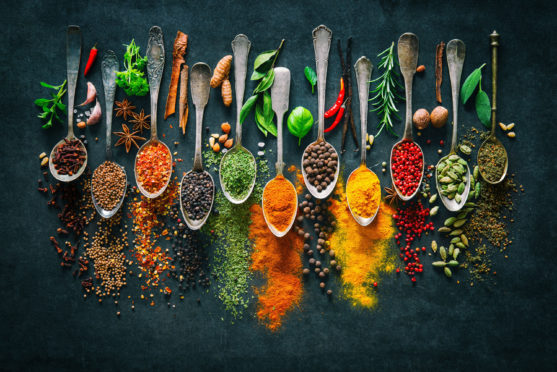
If your kitchen spice rack is shamefully gathering dust, or only gets utilised when you’re whipping up a homemade curry, it’s definitely time to step up your seasoning game beyond plain old salt and pepper.
Besides adding some warmth to your winter cooking, fresh spices pack some pretty impressive health benefits, from reducing inflammation to helping the immune system fight back against pesky seasonal bugs.
“Spices, by definition, are the aromatic part of a plant, whether that’s a root, bark, flower or seed,” explains Rob Hobson, head of nutrition at Healthspan.
“As we’re approaching the time of year when we’re exposed to annoying bugs that can leave us feeling run down, having a few key staple spices on hand could help you keep well this winter.”
What’s more, they’re relatively cheap, last for ages and you probably have most of them stashed in your cupboard already.
Here are five to begin slotting into your diet now…
Curry powder
This blend of spices tends to contain a mixture of ground cumin, ground coriander, ground ginger, chilli powder, fenugreek, turmeric and black pepper, and has a deep, earthy flavour.
“Incorporating curry powder into your meals means you’ll be harnessing a multitude of benefits at once,” explains Rob. “Many of these spices act as anti-inflammatories.”
This is important considering chronic inflammation has been linked to several diseases and conditions, including some cancers and rheumatoid arthritis.
“A lot of research has been conducted around fenugreek in particular,” he adds.
Studies have linked this healing herb to increased testosterone levels in men, noted its potential to aid weight loss and provide pain relief.
How to eat more: Why not combine leftover roast chicken with yogurt and curry powder and use as a sandwich filling or salad ingredient?
Curry powder is also a key ingredient in kedgeree – the British breakfast dish made using curried rice, smoked fish, boiled eggs, parsley and lemon juice.
Ginger
Most people don’t realise ginger is a flowering plant with pretty red blooms, as we’re familiar with buying its knobbly root, which is harvested from the base of the leafy plant.
“Ginger is very pungent and has aromatic citrus notes, with a peppery flavour, which is also reflected in its powdered spice form, too,” says Rob.
“This root has been shown to have strong anti-inflammatory properties, which are a result of the active compounds called gingerols.”
Studies have found this compound can help reduce pain in patients with osteoarthritis or rheumatoid arthritis, as it can inhibit the formation of free radicals in the body.
“Traditionally, ginger is commonly used to treat nausea, so it could be a good option during the festive season to settle delicate ‘morning after’ tummies,” Rob adds.
How to eat more: Try combining ground ginger and fresh lemon with boiling water as a naturally sweet alternative to breakfast tea with refined sugar.
It also works well in homemade baked goods and you can add it to post-workout smoothies for a fiery kick too.
Turmeric
Turmeric has well and truly hit a note with millennials – scroll through any Instagram feed and you’ll likely spot a few riffs on the trend, from turmeric lattes to golden soup.
This potent plant hails from the ginger family and grows in southeast Asia, and while you can sometimes find the whole roots, it’s most commonly bought as a colourful ground spice.
“Turmeric has been shown to contain a compound called curcumin that acts as a powerful anti-inflammatory in the body, and research has pointed out its pain-relieving properties,” notes Rob.
In fact, studies have found that cucurmin may be just as effective as the likes of ibuprofen in treating sports-related injuries.
How to eat more: You can add turmeric to many foods including stews, curries, pasta sauces and soups.
It’s also a super easy way to add an extra kick to scrambled eggs, but don’t add too much, the earthy taste can be overpowering in large doses.
Fennel seeds
If you struggle with bloating after a large meal, a sprinkle of crunchy fennel seeds could be the gentle remedy you’ve been looking for.
“These sweet liquorice-flavoured seeds are popular in cuisines such as those found in the Mediterranean,” Rob says.
He explains that the seed is traditionally used to help relieve bloating and flatulence, and that in traditional eastern medicine, it’s also used as a way to aid digestion, thanks to its flavonoid antioxidants.
How to add more: Fennel seeds work well in tomato-based dishes and can also be sprinkled on roasted vegetables.
This spice is also great when combined with fresh mint to make a tea which helps reduce excess gas.
Cinnamon
Cinnamon is an autumn favourite. Whether you get into the spirit of the season by creating homemade pumpkin spice lattes, or you simply love getting a noseful of it baking in your oven, this sweet spice has plenty of great benefits.
“Cinnamon is a tree bark and the most common variety is called ‘cassia’,” explains Rob.
“The compound in cinnamon responsible for its powerful health benefits is cinnamaldehyde, which studies have found can help fight bacterial infections in the body.”
Like many of the spices on this list, studies have isolated multiple flavonoid compounds in cinnamon that have anti-inflammatory properties.
How to eat more: Cinnamon is a great spice to add to hot drinks.
It also works well in snack bars or sprinkled over fruit or yogurt.
It doesn’t take too much effort to add more spices to your diet and harness their health benefits – the trick is finding your favourites.
Whether you like a spicy kick or an earthy sweetener, make your preferred spices store cupboard essentials.
Both body and mind will thank you.

Enjoy the convenience of having The Sunday Post delivered as a digital ePaper straight to your smartphone, tablet or computer.
Subscribe for only £5.49 a month and enjoy all the benefits of the printed paper as a digital replica.
Subscribe